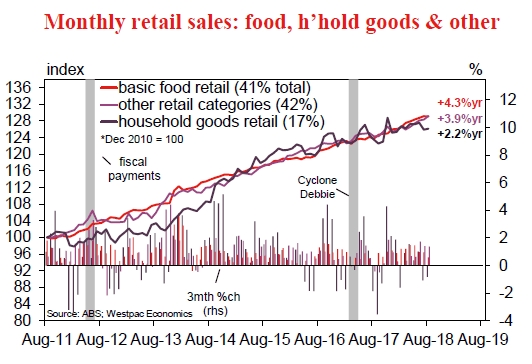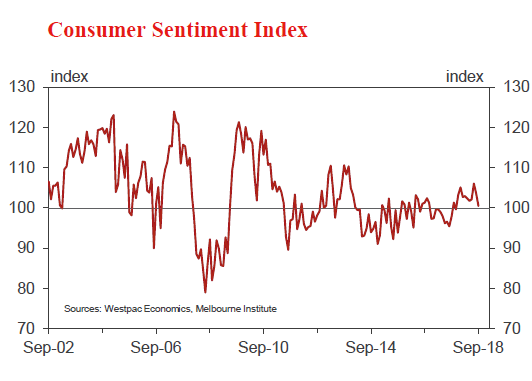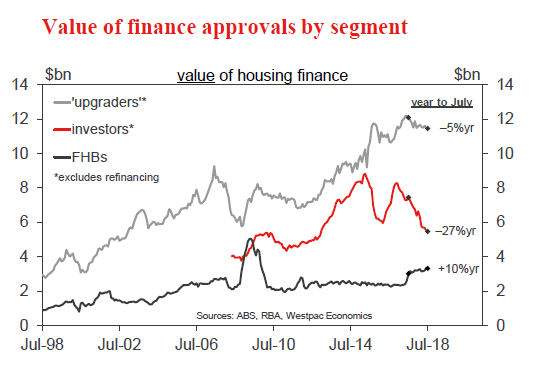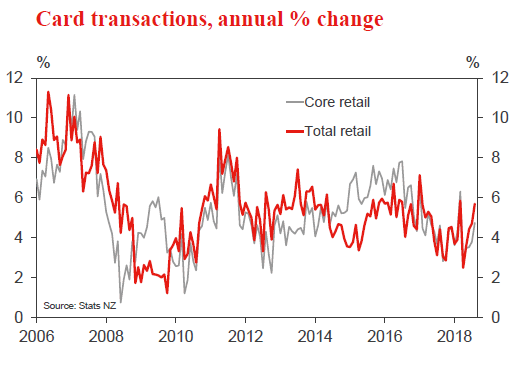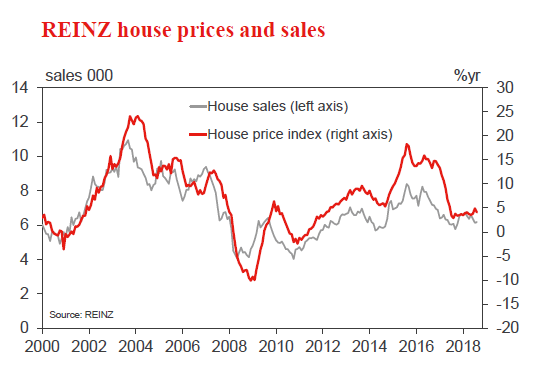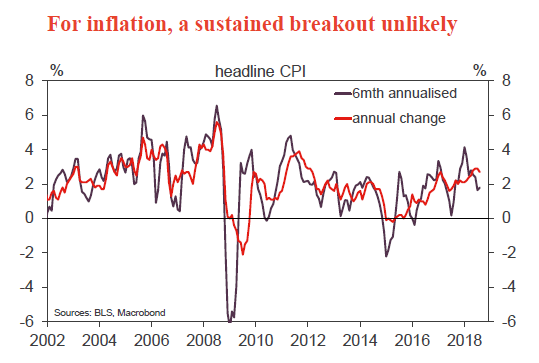Week beginning 8 October 2018
- Big fall in AUD is behind us.
- RBA: Financial Stability Review, Assistant Governor (Economic) Ellis speaks.
- Australia: Westpac-MI Consumer Sentiment, housing finance, NAB business survey.
- NZ: retail card spending, house sales and prices.
- China: new loans and financing, trade balance.
- Europe: Sentix investor confidence.
- US: CPI, Columbus day.
- Key economic & financial forecasts.
Information contained in this report current as at 5 October 2018.
Big Fall in AUD is Behind Us
Over the last month the AUD has held in a range between USD0.73 and USD 0.707. That followed a sharp fall in the AUD from USD0.745 to USD 0.71 over the previous month. Westpac is retaining its target for AUD to end 2018 around USD 0.72. Further weakness is expected for the AUD through the first half of 2019, bottoming out at USD 0.70 around the middle of 2019 before recovering somewhat to USD 0.72 by end 2019.
A year ago when the AUD was trading around USD 0.80, Westpac forecast that the AUD would finish 2018 at USD 0.70. We are pleased that the market has moved broadly in line with our forecasts over that year. A key argument behind our negative view on the AUD hinged around a substantial shift in interest rate differentials between USD and AUD short term rates, a development that was not anticipated by the market.
At that time the market was priced for the RBA cash rate to be around 40 basis points above the federal funds rate by end 2018. Westpac had argued that the differential will be the reverse – that is, the federal funds rate would end 2018 around 40 basis points above the RBA cash rate. We figured that as markets began to price in our view of interest rate differentials, persistent downward pressures would emerge for the AUD.
Markets have actually moved further than we anticipated with both Westpac and market pricing pointing to a margin of 87 basis points by year’s end. That largely reflects our underestimate of the pace of FOMC tightening, since, at the time, there was still considerable uncertainty around whether the Trump Tax Cut Plan and the Fiscal Plan would get Congress approval.
Looking further out, Westpac expects the margin between the RBA cash rate and the federal funds rate to widen to 137 basis points by June next year whereas market pricing is pointing to a margin of 120 basis points.
By December 2019, markets are anticipating a differential of 124 basis points whereas Westpac is expecting the differential of 137 basis points to hold as we anticipate that the FOMC will go on hold beyond June and the RBA will remain on hold in 2019.
It is important to distinguish between the market outlook for FOMC policy and bond rates. This current blow out in bond rates is reflecting a mix of an increased risk premium and longer term FOMC views rather than a more aggressive profile for the near term federal funds rate.
Therefore we are still expecting the RBA cash rate to undershoot the federal funds rate by more than markets are pricing but not significantly so.
Consequently, unlike a year ago, we are not anticipating a further major downdraft on the AUD as a result of markets’ reassessing interest rate differentials.
Unlike interest rate differentials, there is no reliable way of assessing market expectations for the Index of prices of Australia’s commodity exports. But we agree that Australia’s Index of Export Commodities is also an important factor for the AUD.
In fact, if it was only interest rate differentials which were driving the AUD, that wider than expected differential would have been consistent with an even lower AUD than we had anticipated a year ago. The answer to our puzzle is that commodity prices have held up much better through 2018 than we had anticipated.
In our October 2017 Market Outlook, we forecast that our Australian export commodity price Index would fall by around 20% by end 2018. Developments to date now indicate that it will be broadly stable over this period. Of particular importance here has been the resilience of the bulk commodities (iron ore; coking coal; and thermal coal) as China’s anti-pollution policies have favoured high quality Australian bulks over the lower quality local products.
This resilience of commodity prices, despite an anticipated slowdown in China, has explained the relative resilience of the AUD given the dramatic change in interest rate differentials. Looking forward we continue to expect the Commodity Price Index to soften through 2019 as the Chinese economy continues to slow. We are forecasting the Commodity Price Index to fall by around 10% through to mid-2019.
That outlook for the commodity price cycle – which has upside risks – coupled with our expectation of an interest rate differential – which is now largely priced into the market – explains our current forecast that AUD is likely to fall further, although the big falls are now behind us.
While interest rate differentials and commodity prices are key factors for the AUD, any turning point in sentiment towards the USD will also be significant. Through 2018 we have seen generally positive sentiment towards the USD. That is likely to extend through the first half of 2019 but will change when the market becomes convinced that the FOMC is on hold. Our current forecasts envisage the last FOMC rate hike in June next year with the market (and the FOMC itself) taking time to recognise that point. We would expect such a development through the final quarter of 2019 so see the low point in the AUD as June/ September 2019 at USD 0.70 with the AUD lifting to USD 0.72 by end 2019.
However, note how crucially important is our core view that the federal funds rate peaks in June 2019. That target level of 2.875% is below the median FOMC forecast of neutral which was recently updated. The committee sees a range for neutral between 2.5% and 3.5%. We currently favour an estimate nearer 2.5% than 3.5%. Key issues here are that labour productivity in the US remains anchored around 1%, holding potential growth (an important factor for determining neutral) around 1.75%. Fiscal policy will become a drag on US growth in the second half of 2019 as committed spending cuts are delivered; and financial conditions and trade policies tighten sufficiently to restrain US growth to below trend.
Nevertheless, the risks to this outlook are to the upside for the federal funds rate. An extension of the hikes into the second half of 2019 would significantly widen interest rate differentials and sustain confidence in the US dollar for a longer period.
In those circumstances we can envisage the AUD breaking our USD 0.70 forecast to the downside.
The week that was
The tone of data for Australia and the US took diverging paths this week, with the US unquestionably strong as Australia underwhelmed again. However, the biggest headline came not from the data itself, but rather the sharp jump in the US 10 year yield to a peak of 3.23% – a high back to May 2011. As a result, the spread to the Australian 10 year hit 50bps, a level we had not anticipated until June 2019.
The best place to start is the RBA’s October meeting, where the cash rate remained on hold for a 26th consecutive month. The tone of the statement carried no major changes, though importantly credit conditions were described by the RBA as “tighter than they have been for some time”. Whereas the RBA remains focused on investors as the source of weakness, from the new lending data, it is evident that not only has investor momentum turned down sharply (down 27%yr excluding refinancing), but so has the owner-occupier pulse (down 5%yr excluding refinancing). This highlights a material shift in conditions for the housing sector, where national prices are now down 2.7% since their peak a year ago (6.1%yr in Sydney and 3.4%yr in Melbourne) according to data from CoreLogic. The combination of price declines, high household debt and persistent weakness in wage growth is why the RBA continues to see household consumption as a “continuing source of uncertainty” and Westpac believes that consumption growth will slow in 2019.
To us, another reason to be cautious over the outlook for growth is the downturn in dwelling investment that is forming. While investment in this sector has held up better than we anticipated, recent data prints point to the level of activity giving way. In August, dwelling approvals fell 9.4% to be down 13.6% on a year ago. Leading the decline, private unit approvals plunged by 17% in the month to be 24% lower over the year. As a result, activity in this sub-sector is now the weakest it has been since October 2016, and before that June 2014. We expect this downtrend to remain in place over the coming year, and result in dwelling construction falling through 2019 – a distinct contrast to the first half of 2018 when the sector added 0.3ppts to aggregate growth.
Switching to the US, there both the tone of data and central bank communication has been unequivocally positive – and robustly so. While the manufacturing ISM edged back from its 14-year high of August in September, the most-recent result was still at the top end of the historical range. The underlying detail of the September report also continued to show broadbased strength across domestic and external demand – the latter coming despite US dollar strength and a softening global economy. Released a few days later, the non-manufacturing ISM survey buoyed the market with yet more positive sentiment as it surged to a historic high – note this series dates back to 2008. This looks to have been the catalyst for the above jump in term interest rates.
With partial data like this coming on the back of persistent strength in the labour market, it is unsurprising that Chair Powell and other members of the FOMC remain so positive on the outlook. From recent communications, the Committee anticipates enduring strength, but not a building of inflation risks. Indeed, in numerous recent speeches since the September meeting, Chair Powell’s focus has remained squarely on the opportunity that a gradual normalisation of policy provides rather than a need to get ahead of the curve for fear of inflation. The peak of this rate hike cycle will be determined by where neutral lays, and the degree of momentum the economy carries through 2019. We are cautious on both fronts and hence see an end of rate hikes at June 2019. However, we must also remain wary of the upside risks to rates that could spring from an extended period of above-trend growth and further employment gains (an inflation threat), or an uplift in productivity that boosts potential growth and hence the neutral rate.
This week’s market action highlight that participants are beginning to not only fully price in our baseline view of three further fed fund rate hikes to June 2019 but also, at the margin, a chance these upside risks could develop. Our latest Market Outlook publication will be released later today, and covers all of the detail of this debate and the implications for financial markets.
Finally on Asia, the September PMIs for China reported a further deterioration in external orders consistent with softer global growth. However, domestic momentum was again shown to be robust, particularly in the services sector. As the tariff effect builds into 2019, Chinese authorities will look to provide an offset by supporting the domestic economy. This should see GDP growth sustained above 6.0% through 2019. Elsewhere in Asia, those most exposed to US/China tensions are under stress and face an uncertain outlook (Taiwan is the best example). Momentum in other countries in the region however remains around trend. For some in this group, there is tentative evidence that currency depreciation is aiding export volumes – India being the prime example. However, it is not all good news for these nations, with inflation also having been boosted by the lower currency, begetting a need for central banks to react by tightening policy.
Chart of the week: Australian retail sales
Australian retail sales increased by 0.3% in August, just above Westpac and consensus expectations for a 0.2% gain.
The store type detail showed food flat in the month and as it accounts for 41% of total sales, it weighed on the headline monthly change. With food, it is typically unclear whether nominal changes are reflective of prices or volumes. The flat read in August follows four months of consistent 0.3% increases.
Other categories were more positive in August, department stores up 0.9%, clothing +0.8% and cafes and restaurants +0.7%. Household goods retailing remains subdued, up just 0.2% with electrical goods retailing down 0.5%. Of particular interest within household goods is any spill-overs from the declines in home prices. Absolute spending on household goods is flattening out while the other retail categories have continued at trend.
New Zealand: week ahead & data wrap
A winter of discontent?
Business confidence has fallen significantly over the past year. There’s no doubt that at least some of this comes from firms registering their discontent with the new Government’s policies. But there are also some genuine reasons for concern, as firms are finding their margins squeezed between rising costs and slowing consumer demand.
This week saw the release of the Quarterly Survey of Business Opinion (QSBO) for the September quarter. General sentiment fell to -28, its lowest level since 2009, matching the fall that we’ve seen in the monthly ANZ survey. The more informative ownactivity measure fell by a smaller degree, but was still at its lowest level since 2012. On its own, the survey suggests some downside risk to our forecast of a 0.7% rise in September quarter GDP.
Readers may be feeling some fatigue at the debate around whether business confidence surveys tell us anything useful. However, the QSBO warrants some attention for a number of reasons.
The first is that, over time, the QSBO has proven to be the more reliable early indicator of economic activity, compared to the monthly survey. Indeed, the message from the latest QSBO was a little more nuanced than what we’ve seen elsewhere: firms reported that the last three months were tougher, but the outlook for the next three months was little changed from the previous survey.
The QSBO’s better track record as an indicator of GDP largely stems from the fact that, unlike the monthly survey, it hasn’t shown a persistent downward bias under centre-left governments. However, that’s not to say that it is entirely free from political influences.
The latest QSBO explored this aspect by asking businesses why they responded the way that they did. For those who see the economic outlook getting worse, government policy was by far the most common reason given. (For firms who are more optimistic, finding workers is their biggest concern.) Unfortunately, the survey didn’t uncover which particular policies are worrying businesses, but employment law is likely to be high on the list.
There are some interesting parallels between today and the year 2000, during what was dubbed the ‘winter of discontent’. Then, a recently elected Labour-led Government was also working to pass legislation (the Employment Relations Act) that would strengthen workers’ rights to collective bargaining with employers. Business organisations lobbied vigorously against these changes, and surveys of business confidence (including the QSBO) fell suddenly and sharply in mid-2000. Notably, within a few months after the legislation was passed, business confidence rose back to its previous levels.
So is the recent plunge in business confidence just a message of protest? No, or at least not entirely. There is plenty of corroborating evidence that the economy’s pace of growth has slowed since its peak in 2016 – though it’s nowhere near the recessionary levels that the headline measures of business confidence would imply. Moreover, the details of the QSBO suggest that businesses are not merely unhappy with who’s in power, but are genuinely feeling the pinch in some areas.
The first aspect is that over the last few quarters a growing number of firms have said that demand is the biggest constraint on their growth (as opposed to supply-side factors such as the availability of labour). Concerns about demand haven’t risen dramatically, but this marks a break in the downward trend going back to 2010, as the economy recovered from the Global Financial Crisis.
There is certainly evidence that growth in consumer spending has slowed in the last year or so, in line with the slowdown in house price growth. We expect that the Government’s Families Package, which came into effect from July, will help to lift spending growth in the near term. But since the package is largely aimed at lowincome households, the effects won’t be felt evenly – for instance, sales of big-ticket items such as cars are unlikely to see a boost.
The second aspect is that a growing number of firms are reporting an increase in their costs. Some of the likely factors behind this are the increase in the minimum wage earlier this year, rising oil prices, and the fall in the exchange rate which has made imported goods and equipment more expensive.
There has also been a rise in the number of firms reporting an increase in their own prices, but not to the same extent as for their costs. In some ways this relates to the previous issue – demand isn’t strong enough for firms to feel confident about passing on cost increases. As a result, more firms are seeing a squeeze on their profit margins, and they expect this squeeze to continue.
Unfortunately, those cost pressures appear to have further to run. As of this week, the New Zealand dollar has fallen to its lowest level since early 2016, with the US dollar in ascendency as its economy gathers speed and US interest rates rise. At the same time, world oil prices have surged above $80 a barrel, due to strong world demand and restricted supply from the OPEC countries. Together, these forces have pushed petrol pump prices up to record highs, and an increase in fuel taxes from this week (up 4c a litre including GST) will add to the pain.
One of the effects of higher petrol prices is that they eat into household budgets, leaving less room for spending in other areas. Next week’s electronic card spending figures will shed some light on how consumers fared over September. Data from Paymark (the largest cards processor) shows a solid rise in total spending for the month, but it remains to be seen how much of this was devoted to fuel spending.
Another implication is that it’s increasingly likely that inflation will push above the 2% midpoint of the Reserve Bank’s target range, for at least a short period. A jump in inflation caused by fuel prices is the kind of thing that the Reserve Bank can look through, if there’s reason to believe that it won’t continue to rise at the same pace. Nevertheless, it’s markedly different from the central case that the RBNZ laid out in its August Monetary Policy Statement, where inflation was expected to remain below 2% until early 2021. At the margin, rising inflation could make OCR cuts a harder sell.
Data Previews
Aus Oct Westpac-MI Consumer Sentiment
Oct 10 Last: 100.5
The Westpac Melbourne Institute Index of Consumer Sentiment declined 3% to 100.5 in September, marking the weakest read since November last year. Confidence was clearly knocked by increases in mortgage interest rates; political instability and ongoing household budget pressures. That said, there appeared to be some support from the strong June quarter growth figures and an encouraging lift in consumers’ labour market expectations. Sentiment overall is still in positive territory, albeit only just above the 100 level. A notable feature of the firmer sentiment reads in 2018 is the more even spread across states with a clear improvement in the previously weak mining states.
The October survey is in the field from October 1-6. The backdrop looks a little more settled this month, suggesting some of the impact from September’s negatives may dissipate. That said, global trade tensions, slipping house prices and sluggish income growth will remain negatives for sentiment.
Aus Aug housing finance (no.)
Oct 12, Last: 0.4%, WBC f/c: –1.5%
Mkt f/c: -1.0%, Range: -3.0% to 0.5%
While the headline number of owner occupier loans edged up 0.4% in July, this was entirely due to a 3% surge in refi activity with the number of ‘new’ loans down 0.8%mth to be 9.6% lower over the last year. The value of investor loans also declined 1.3% to be 15.7% lower over the year (an estimated –27%yr ex refi). The soft tone in the detail is consistent with the continued slowing in market conditions evident in auction markets and prices.
The August update is likely to be a weak one. Housing markets continued to correct in the month, albeit with auction clearance rates showing some signs of finding a base. Overall we expect owner occupier finance approvals to be down 1.5%. The value of investor loans will again be of interest, as will the average value of owner occupier loans given the tightening in lending standards that looks to be behind the latest softening in conditions and prices.
NZ Sep retail card spending
Oct 10, Last: +1.0%, Westpac f/c: +0.7%
Retail spending rose by 1% in August. While spending levels were boosted by an increase in fuel prices, there was growth across all major categories. Spending has been supported by the Government’s Families Package, which came into effect on 1 July and has boosted the incomes of many households.
We expect a 0.7% increase in retail spending in September. However, with fuel prices pushing upwards, core spending growth is expected to be more modest at around 0.5%. Increases in disposable incomes are adding to spending in some areas like consumables. But at the same time, the continuing slowdown in the housing market is dampening spending on items like household furnishings.
NZ Sep house sales and prices
Oct 10 (tbc), Sales last: +0.7%, Prices last: +4.1%yr
The housing market has cooled over the past year. Nationwide house sales have slowed, prices in Auckland have drifted lower, and there has been continued softness in Canterbury. However, price growth remains firm in most regions outside of Auckland and Canterbury.
We expect nationwide average house prices to remain fairly subdued over the remainder of the year, with Auckland and Canterbury underperforming the rest of the country. Fixed mortgage rates have fallen recently following a dovish tilt from the RBNZ, and this is likely to provide some boost to house prices. However, there is still a sense of nervousness related to changes in Government policy. Such concerns are particularly acute in Auckland, where there is a greater prevalence of investors and affordability remains highly stretched. At the same time, Canterbury’s housing market is continuing its gradual post-earthquake adjustment.
US Sep CPI
Oct 11, last 0.2%, WBC 0.2%
The US headline CPI rose 0.2% in August. The core measure was softer at just 0.1%. Both outcomes were below expectations, as declines in health care and clothing dampened inflation pressures from gasoline and rents. • While the annual headline rate is materially above the FOMC’s 2.0%yr inflation target (2.7%yr), on a six and three month basis, the pulse is broadly in line – respectively 1.8% and 2.1% annualised. Core inflation is also consistent with target, at 1.9% on a six-month annualised basis and 2.2%yr for the year.
As per their recent communications, the FOMC see little risk of an acceleration in underlying inflation away from target. Energy prices will however continue to create sporadic volatility, given recent movements in the price of oil.




